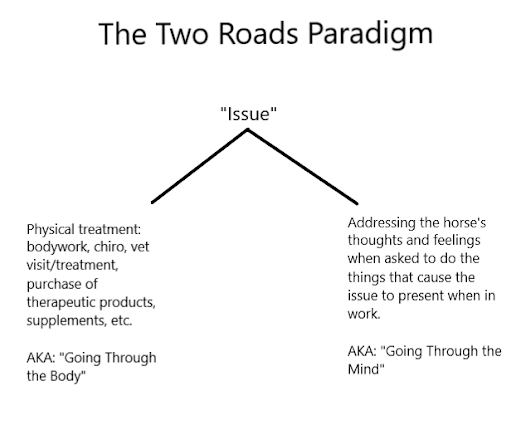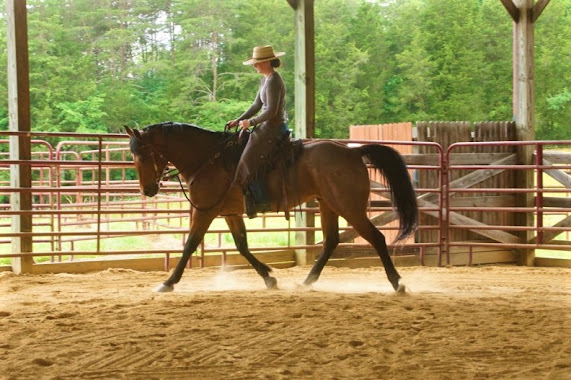A cautionary note: I am not, I repeat (emphatically) I am NOT saying that the reasons why our horses "act out" lack root causes that are physical and might need professional intervention. What I AM saying is that the percentage that are purely physical are far fewer than we often A) think, and B) try to treat as such.
And, believe it or not, I am still coming to terms with this idea even though I had an inkling long before I met Harry Whitney, so perhaps I should go back to the beginning.
What seems like a lifetime ago I did equine bodywork. I'd visit the same horses week after week and largely work on the same "issues" each time.
What I found over time is very few of the owners recognized the role their riding was playing in their horse's recurrent "issues". There was this notion that these "issues" happened to materialized as a simple byproduct of being ridden and just needed some extra care to keep in check.
Essentially, these "issues" were reported as, thought about and treated like they were completely unrelated to anything concerning the horse itself. I experienced this odd divorcing of realities so many times I lost count. It was this repeated experience that drove me to start teaching as it occurred to me how much more useful I could be to both the horse and the rider if I could guide them on how they could address these "issues" in their riding. Alas, maybe not the smartest business move but I don't regret it as it started me on this journey of obsessing over posture and biomechanics. That obsession is what led me to idea of The Two Roads. It was then Harry Whitney who demonstrated over and over that this idea I'd been wrestling had quite a bit of merit.

There's a lot of handy analogies you could use depending on your tastes. Ray Hunt and Tom Dorrance both used variations on "going through the mind [to get to the body]". Deb Bennett describes them as the "Greater and Lesser Paths". I coined "The Two Roads" because it describes the exact mental conundrum I would find myself in time after time with different horses. Do I go this way and see if I should address it physically, or do I go this way and see if I can address it mentally (and thus address the physical presentation of the deeper problem)?
It was ultimately Harry Whitney who demonstrated that you don't even have to think about "Going Through the Body". It can all be done through the mind. Watching Harry work with various horses - some of whom weren't even entirely sound - proved to me that you can fix a physically-presenting issue by going entirely through the horse's thoughts.
I realize this statement carries a lot of weight and tends to elicit pretty strong responses. I can hear the foot stomping and hand wringing. I still struggle with it myself not because I don't believe in it but because I come from such a strong bodywork-based/biomechanical background that shifting my thinking requires a lot of mental energy and practice.
When we think of riding, we tend to think mostly about the interactions between our body and the horse's body: horse is pushing on your right leg so you add pressure from your right calf, that sort of thing. It's a very linear way to think but a lot of people spend their whole riding lives in this place.
If you're a bit further along, you recognize that the state of mind the horse is in has a direct effect on how he responds to your physical cues. Or, if he responds at all.
If you're even a bit further along, you recognize that if you can influence the horse's state of mind, and thus his thoughts, you can control the body directly. You recognize that all those physical "issues" are just symptoms of the horse's thoughts.
An example from the one and only Soni (which also happens to be an excellent example of how these things can come to be):
Per Soni's original owner, his life has gone something like this: bought as a yearling and shipped to Vermont. Leased out to a gal who wanted to train him up as a barrel horse. Sent back three months later. Sat in pasture. Leased out again. Sent back a few months later because he supposedly bucked her off and dragged her. Sat in pasture. Got injured on a corral panel fence (rumor was there was a goat involved) resulting in a big ol' crush-type injury scar on his left shoulder (see photo below). Healed up. Got leased out a third time and returned in quick succession because he "wasn't a good fit". Sat in pasture until he was 12 and came to me.
I don't need any more detail to know this horse was never started properly.
"And so they are started, so they go."
So here we are. Soni is nearing 17 years old having spent his entire life up until he was 12 operating with minimal education from people. The education he did get proved detrimental as it gave him a very, very poor foundation for ridden work. He also had an injury which - while superficial - contributed to his desire to compensate how he saw fit.
"Compensate": the ways in which the horse turns his body into a pretzel to avoid pain or discomfort.
I'm still working to un-pretzel this horse; as it is it took me quite a long time to even begin to figure out why he seemed so complex, more so than any other horse I've worked with. But those compensations, those patterns, didn't just materialize out of nowhere. The horse had to come up with them first. He had to THINK about what to do. Those thoughts eventually became unconscious habit in the same way you or I develop such tendencies and it's those thoughts that are the root cause. Those are the things I go after every time I work with him, each time attempting to disrupt the old thoughts and offer the news ones. It's a slow, slow process for a horse with as much practice in "the old ways" as him.
In Soni's case, this means a strong desire to "think right", as his pattern has become to lean on the right front leg. It also means a strong desire to "think forward", as he was never taught how to "think up and out" by shifting his weight onto his hocks and pushing off his hind end to move forward. Get the thoughts lined up and the body takes care of itself.
The caveat, of course, is that over time a recurrent thought can turn into a real physical problem. A tendency to always think more to the right than the left has caused Soni to develop tension in his right poll and TMJ/masseter. That discomfort he feels is absolutely real and palpating him in those areas used to cause him to darn near flip over backwards. Steady work to block the old thought and offer the new one has done quite a bit to relieve his discomfort - he still guards to some degree but it's far less than he used to and continues to improve with steady work. I've also utilized Shockwave therapy on his poll a handful of times to help minimize pain while I continued to work on redirecting his thoughts.
It's in this way that I find physical treatments the most beneficial. Otherwise, without identifying the true root cause, you're just throwing spaghetti against a wall and seeing what sticks.
I know the question that is burning in your brain because it's the same one I've wrestled with since I reached this phase of my horsemanship: "yabbut, how do I know what to DO? How do I know how to block a thought, and how do I know what new thought to introduce?"
That, friends, is the journey. Welcome to the beginning. I'll be sure to share what I've figured out as we go.



Comments
Post a Comment